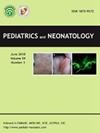Pulmonary function and body composition parameters of children with cystic fibrosis from a hight complexity institution between 2015 and 2018
IF 2.3
4区 医学
Q2 PEDIATRICS
引用次数: 0
Abstract
Background
An adequate nutritional status in patients with cystic fibrosis correlates with higher survival and better pulmonary function. Body mass index (BMI) is an anthropometric indicator with independent association with pulmonary function, and it can hide alterations of nutritional status in cystic fibrosis.
Objective
To determine the relationship of lung function with BMI and body composition parameters in children with cystic fibrosis in a Hight Complexity institution between 2015 and 2018.
Materials and methods
It was an observational study with analytical, cross-sectional, and retrospective scope, including 33 patients between 5 and 17 years old. Spearman's test was applied to evaluate correlation of FEV1 (forced expiratory volume in first second) with BMI and five body composition parameters by bioelectrical impedance using InbodyS10 equipment. Statistical significance was considered with p < 0.05.
Results
Positive correlation was obtained between FEV1 and appendicular skeletal muscle mass between lung function and percentage of fat-free mass (p = 0.006) and phase angle (p = 0.001). Percent fat mass had a negative correlation with FEV1 (p = 0.007). BMI and fat free mass index did not correlate with lung function (p = 0.085).
Conclusions
Appendicular skeletal muscle mass correlated better than BMI with lung function in children with cystic fibrosis. It is recommended to perform anthropometric follow-up by BMI complemented with body composition study in children with cystic fibrosis. Analyses with larger populations are required to standardize its use.
2015年至2018年期间一家高度复杂机构囊性纤维化患儿的肺功能和身体成分参数。
背景囊性纤维化患者充足的营养状况与较高的存活率和较好的肺功能相关。体质指数(BMI)是一项与肺功能有独立关联的人体测量指标,它可以隐藏囊性纤维化患者营养状况的改变。目的确定2015年至2018年间高复杂性机构中囊性纤维化儿童肺功能与BMI和身体成分参数的关系。使用 InbodyS10 设备通过生物电阻抗评估 FEV1(第一秒用力呼气容积)与 BMI 和五项身体成分参数的相关性,采用斯皮尔曼检验。结果FEV1与肺功能和无脂肪质量百分比(p = 0.006)和相位角(p = 0.001)之间的骨骼肌质量呈正相关。脂肪质量百分比与 FEV1 呈负相关(p = 0.007)。结论在囊性纤维化儿童中,垂直骨骼肌质量与肺功能的相关性优于体重指数。建议在对囊性纤维化患儿进行人体测量随访的同时,通过 BMI 进行身体成分研究。需要对更多人群进行分析,以规范其使用。
本文章由计算机程序翻译,如有差异,请以英文原文为准。
求助全文
约1分钟内获得全文
求助全文
来源期刊

Pediatrics and Neonatology
PEDIATRICS-
CiteScore
3.10
自引率
0.00%
发文量
170
审稿时长
48 days
期刊介绍:
Pediatrics and Neonatology is the official peer-reviewed publication of the Taiwan Pediatric Association and The Society of Neonatology ROC, and is indexed in EMBASE and SCOPUS. Articles on clinical and laboratory research in pediatrics and related fields are eligible for consideration.
 求助内容:
求助内容: 应助结果提醒方式:
应助结果提醒方式:


